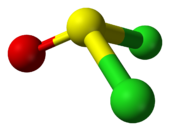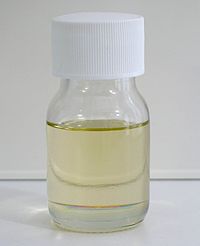- Thionyl chloride
-
Thionyl chloride 

 Sulfurous dichlorideOther namesThionyl dichloride
Sulfurous dichlorideOther namesThionyl dichloride
Sulfurous oxychloride
Sulfinyl chloride
sulfinyl dichloride
Dichlorosulfoxide
Sulfur oxide dichloride
Sulfur monoxide dichloride
Sulfuryl(IV) chlorideIdentifiers CAS number 7719-09-7 
PubChem 24386 ChemSpider 22797 
EC number 231-748-8 UN number 1836 ChEBI CHEBI:29290 
RTECS number XM5150000 Jmol-3D images Image 1 - ClS(Cl)=O
Properties Molecular formula SOCl2 Molar mass 118.97 g/mol Appearance clear; colorless to yellow
odorous liquidDensity 1.638 g/cm3, liquid Melting point −104.5 °C
Boiling point 74.6 °C
Solubility in water reacts Solubility soluble in benzene, chloroform, CCl4 Refractive index (nD) 1.517 (20 °C) [1] Viscosity 0.6 cP Structure Molecular shape pyramidal Dipole moment 1.4 D Hazards MSDS External MSDS EU Index 016-015-00-0 EU classification Corrosive (C) R-phrases R14, R20/22, R29, R35 S-phrases (S1/2), S26, S36/37/39, S45 NFPA 704 Flash point Non-flammable Related compounds Related thionyl halides Thionyl fluoride
Thionyl bromideRelated compounds Sulfuryl chloride
Selenium oxydichloride chloride (verify) (what is:
chloride (verify) (what is:  /
/ ?)
?)
Except where noted otherwise, data are given for materials in their standard state (at 25 °C, 100 kPa)Infobox references Thionyl chloride is an inorganic compound with the formula SOCl2. It is a reactive chemical reagent used in chlorination reactions. It is a colorless, distillable liquid at room temperature and pressure that decomposes above 140 °C. Thionyl chloride is sometimes confused with sulfuryl chloride, SO2Cl2, but the properties of these compounds differ significantly. Approximately 45,000 tons per year of SOCl2 were produced in the early 1990s.[2]
Contents
Properties and structure
The molecule SOCl2 is pyramidal, indicating the presence of a lone pair of electrons on the sulfur(IV) center. In contrast, the stoichiometrically related species COCl2 is planar. SOCl2 reacts with water to release hydrogen chloride and sulfur dioxide.
- SOCl2 + H2O → 2 HCl + SO2
Production
The major industrial synthesis involves the reaction of sulfur trioxide and sulfur dichloride:[3]
- SO3 + SCl2 → SOCl2 + SO2
Other methods include syntheses from phosphorus pentachloride, chlorine, or phosgene:
- SO2 + PCl5 → SOCl2 + POCl3
- SO2 + Cl2 + SCl2 → 2 SOCl2
- SO3 + Cl2 + 2 SCl2 → 3 SOCl2
- SO2 + COCl2 → SOCl2 + CO2
The first of the above four reactions also affords phosphorus oxychloride (phosphoryl chloride), which resembles thionyl chloride in many of its reactions.
Applications
Thionyl chloride is mainly used in the industrial production of organochlorine compounds, which are often intermediates in pharmaceuticals and agrichemicals.
Organic chemistry
Thionyl chloride is widely used in organic synthesis. For some applications, it requires purification.[4] Classically, it converts carboxylic acids to acyl chlorides:[5]
Alcohols react with thionyl chloride to give the corresponding alkyl chlorides. This method is known as Darzan's process.[6] This reaction proceeds via an internal nucleophilic substitution.
It is preferred over other reagents such as phosphorus pentachloride because the products of the thionyl chloride reactions, HCl and SO2, are gaseous, which simplifies the purification of the product. Excess thionyl chloride can be readily removed by distillation.
Sulfonic acids react with thionyl chloride to produce sulfonyl chlorides.[7][8] Sulfonyl chlorides have also been prepared from the direct reaction of the corresponding diazonium salt with thionyl chloride.[9] Likewise, thionyl chloride will transform sulfinic acids into sulfinyl chlorides[10] and phosphonic acids into phosphoryl chlorides. Thionyl chloride will react with primary formamides to form isocyanides.[11] Amides will react with thionyl chloride to form imidoyl chlorides. However, primary amides under heating with thionyl chloride will continue on to form nitriles.[12]
Thionyl chloride can also produce nitriles from amides via E2 elimination.[13]
Inorganic chemistry
Anhydrous metal chlorides may be obtained from hydrated metal chlorides by refluxing in freshly distilled thionyl chloride:[14]
- MCln·xH2O + x SOCl2 → MCln + x SO2 + 2x HCl
Other applications
Thionyl chloride is a component of lithium-thionyl chloride batteries, where it acts as the positive electrode (cathode) with lithium as the negative electrode (anode).
Safety
SOCl2 is a reactive compound that can explosively release dangerous gases upon contact with water and other reagents. Industrial production of thionyl chloride is controlled under the Chemical Weapons Convention, where it is listed in Schedule 3. Thionyl chloride is used in the "di-di" method of producing G-series nerve agents.
References
- ^ Pradyot Patnaik. Handbook of Inorganic Chemicals. McGraw-Hill, 2002, ISBN 0070494398
- ^ Hans-Dietrich Lauss, Wilfried Steffens “Sulfur Halides” in Ullmann's Encyclopedia of Industrial Chemistry Wiley-VCH, Weinheim, 2005.doi:10.1002/14356007.a25_623
- ^ Greenwood, Norman N.; Earnshaw, A. (1984). Chemistry of the Elements. Oxford: Pergamon. p. 820. ISBN 0-08-022057-6..
- ^ Friedman, L. and Wetter, W. P., "Purification of Thionyl Chloride", J. Chem. Soc. A, 1967, 36-8.doi:10.1039/J19670000036
- ^ Allen, C. F. H.; Byers, Jr., J. R.; Humphlett, W. J. (1963), "Oleoyl chloride", Org. Synth., http://www.orgsyn.org/orgsyn/orgsyn/prepContent.asp?prep=cv4p0739; Coll. Vol. 4: 739; Rutenberg, M. W.; Horning, E. C. (1963), "1-Methyl-3-ethyloxindole", Org. Synth., http://www.orgsyn.org/orgsyn/orgsyn/prepContent.asp?prep=cv4p0620; Coll. Vol. 4: 620
- ^ Mondanaro, K. R.; Dailey, W. P. (2004), "3-Chloro-2-(chloromethyl)-1-propene", Org. Synth., http://www.orgsyn.org/orgsyn/orgsyn/prepContent.asp?prep=v75p0089; Coll. Vol. 10: 212; Krakowiak, K. E.; Bradshaw, J. S. (1998), "4-Benzyl-10,19-diethyl-4,10,19-triaza-1,7,13,16-tetraoxacycloheneicosane", Org. Synth., http://www.orgsyn.org/orgsyn/orgsyn/prepContent.asp?prep=cv9p0034; Coll. Vol. 9: 34; Feng Xu, Bryon Simmons, Robert A. Reamer, Edward Corley, Jerry Murry, and David Tschaen (2008). "Chlorination/Cyclodehydration of Amino Alcohols with SOCl2: An Old Reaction Revisited". J. Org. Chem. 73 (1): 312–5. doi:10.1021/jo701877h. PMID 18052293.
- ^ Weinreb, S. M.; Chase, C. E.; Wipf, P.; Venkatraman, S. (2004), "2-Trimethylsilylethanesulfonyl chloride (SES-Cl)", Org. Synth., http://www.orgsyn.org/orgsyn/orgsyn/prepContent.asp?prep=v75p0161; Coll. Vol. 10: 707
- ^ Hazen, G. G.; Bollinger, F. W.; Roberts, F. E.; Russ, W. K.; Seman, J. J.; Staskiewicz, S. (1998), "4-Dodecylbenzenesulfonyl azides", Org. Synth., http://www.orgsyn.org/orgsyn/orgsyn/prepContent.asp?prep=cv9p0400; Coll. Vol. 9: 400
- ^ Philip J. Hogan and Brian G. Cox (2009). "Aqueous Process Chemistry: The Preparation of Aryl Sulfonyl Chlorides". Org. Process Res. Dev. 13 (5): 875–879. doi:10.1021/op9000862.
- ^ Hulce, M.; Mallomo, J. P.; Frye, L. L.; Kogan, T. P.; Posner, G. H. (1990), "(S)-(+)-2-(p-toluenesulfinyl)-2-cyclopentenone: Precursor for enantioselective synthesis of 3-substituted cyclopentanones", Org. Synth., http://www.orgsyn.org/orgsyn/orgsyn/prepContent.asp?prep=cv7p0495; Coll. Vol. 7: 495; Kurzer, F. (1963), "p-Toluenesulfinyl chloride", Org. Synth., http://www.orgsyn.org/orgsyn/orgsyn/prepContent.asp?prep=cv4p0937; Coll. Vol. 4: 937
- ^ Niznik, G. E.; Morrison, III, W. H.; Walborsky, H. M. (1988), "1-d-Aldehydes from organometallic reagents: 2-methylbutanal-1-d", Org. Synth., http://www.orgsyn.org/orgsyn/orgsyn/prepContent.asp?prep=cv6p0751; Coll. Vol. 6: 751
- ^ Krynitsky, J. A.; Carhart, H. W. (1963), "2-Ethylhexanonitrile", Org. Synth., http://www.orgsyn.org/orgsyn/orgsyn/prepContent.asp?prep=cv4p0436; Coll. Vol. 4: 436
- ^ John E. McMurry (2010). Fundamentals of Organic Chemistry (7th ed.). Cengage Learning. p. 767. ISBN 1439049718.
- ^ Alfred R. Pray, Richard F. Heitmiller, Stanley Strycker (1990). "Anhydrous Metal Chlorides". Inorganic Syntheses. Inorganic Syntheses 28: 321–323. doi:10.1002/9780470132593.ch80. ISBN 9780470132593.
External links
Categories:- Thionyl compounds
- Oxochlorides
- Nonmetal halides
- Reagents for organic chemistry
- Inorganic sulfur compounds
- Lachrymatory agents
Wikimedia Foundation. 2010.




